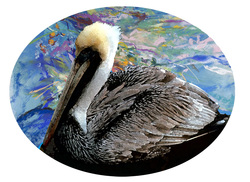
California brown pelicans were delisted from the Endangered Species list in 2009. Roughly 90 percent of them typically breed and rear their young off the coasts of western Mexico, with the remainder breeding in the Channel Islands in Southern California. A 2014 population survey has uncovered a drastic decline in the number of California brown pelicans breeding in the Gulf of California.
University of California, Davis, professor emeritus and wildlife biologist Dan Anderson completed the survey of California brown pelican breeding colonies in late May with colleagues from the Mexican conservation agency National Commission of Natural Protected Areas (CONANP). The scientists found that this year, areas that typically host hundreds or thousands of nesting pairs held only a few hundred at most, and in some cases zero nesting pairs. "Populations do decline somewhat during El Niño years, but not nearly as drastically as what we saw widespread this year," says Dan Anderson.
This spring, when the birds arrived at breeding colonies, numbers were down and many arrived late. Of those who nested, many abandoned their nests when they could not find enough food to sustain their stay. Observers are also seeing large numbers migrating across the Baja Peninsula roughly six weeks early.
The survey’s findings include:
The facts in this article have been documented and are courtesy of the University of California, Davis. LadyWhoLovesBirds is an avid conservationist and wildlife artist. Her love of birds is the focus of her art work which can be viewed at her website, www.LadyWhoLovesBirds.com and her Etsy Shoppe: https://www.etsy.com/shop/LadyWhoLovesBirds.
University of California, Davis, professor emeritus and wildlife biologist Dan Anderson completed the survey of California brown pelican breeding colonies in late May with colleagues from the Mexican conservation agency National Commission of Natural Protected Areas (CONANP). The scientists found that this year, areas that typically host hundreds or thousands of nesting pairs held only a few hundred at most, and in some cases zero nesting pairs. "Populations do decline somewhat during El Niño years, but not nearly as drastically as what we saw widespread this year," says Dan Anderson.
This spring, when the birds arrived at breeding colonies, numbers were down and many arrived late. Of those who nested, many abandoned their nests when they could not find enough food to sustain their stay. Observers are also seeing large numbers migrating across the Baja Peninsula roughly six weeks early.
The survey’s findings include:
- At Angel de la Guarda, there were 120 nesting pairs and zero young in 2014, which is less than 2 percent of the past four years’ average since the pelicans were delisted. For comparison, in 2006—considered a “good” year for the pelicans—there were 3,550 nesting pairs and 3,905 young on the island.
- At Isla San Luis, there were 465 nesting pairs producing 16 young (9 percent of normal) in 2014, compared with 5,400 nesting pairs and 5,940 young in 2006.
- At Isla Piojo, there were 70 nesting pairs and zero young in 2014 (19 percent of normal), compared with 600 nesting pairs and 660 young in 2006.
- Low breeding numbers are often associated with El Niño conditions, which bring warmer waters to the Eastern Pacific Ocean. However, this year, the pelicans began showing signs of trouble well ahead of this summer, when El Niño was predicted to begin.
The facts in this article have been documented and are courtesy of the University of California, Davis. LadyWhoLovesBirds is an avid conservationist and wildlife artist. Her love of birds is the focus of her art work which can be viewed at her website, www.LadyWhoLovesBirds.com and her Etsy Shoppe: https://www.etsy.com/shop/LadyWhoLovesBirds.

 RSS Feed
RSS Feed
